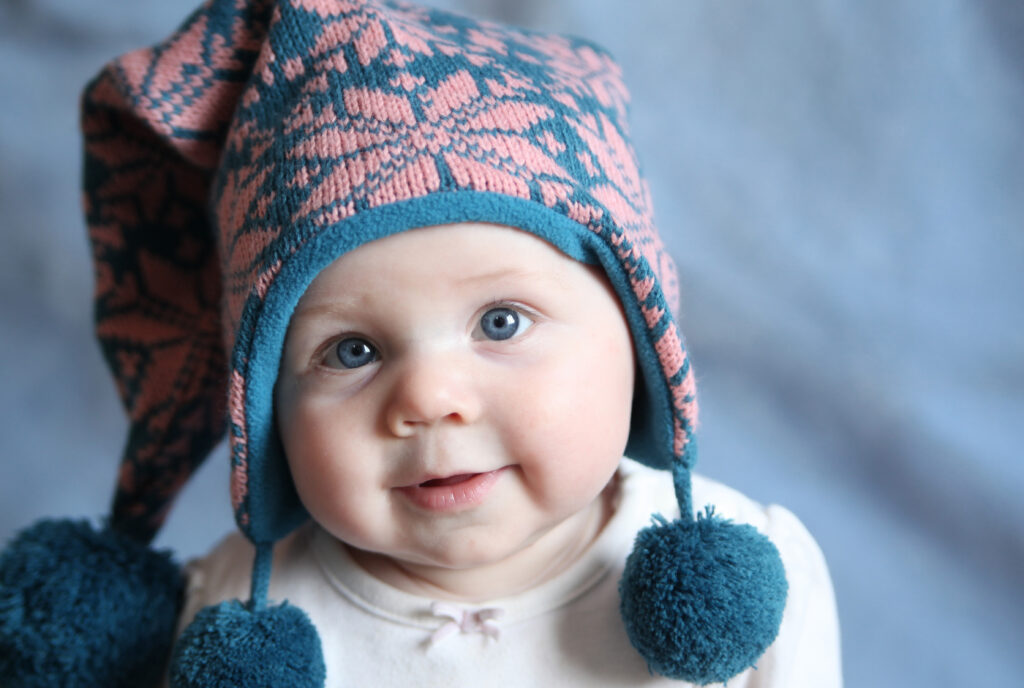The leaves have been changing for a few weeks now, and with our first real coating of snow comes a new challenge: keeping your smallest kiddos warm. Older kids can—and often will—tell you when they’re cold. But what about babies who can’t quite tell us exactly how they’re feeling? Here are a few tips to keep your baby warm and cozy this winter, but also safe.
STAYING SAFE
First thing’s first: when dressing for colder weather, keep in mind that babies should never wear bulky coats or outerwear in their car seat. This advice is true for kids of any age in a car seat, but is most critical for babies. Bulky layers add space between your child and their harness. This causes the straps to be looser, and in the event of a crash can keep the seat from restraining your child properly. Always place your child in the car seat in multiple thin, fitted layers (such as a onesie, then a thermal-knit shirt and a thin fleece top), and then cover with blankets once they’re secure.
GETTING TO THE CAR
So how do you get from a nice, warm house to the car without creating a baby-popsicle? If you have a garage or the ability to remote-start your car, both are great options. Even without remote-start, if the car is already warmed up babies will survive the short amount of time you have the door open to strap them into the seat with less fussing. Keeping them wrapped in a blanket in between also helps. If your child is still small enough for removable baby seats, having them strapped in and snuggled up in a blanket before ever leaving the house is ideal—keeping in mind the no-bulky-coats rule.
OUT AND ABOUT
We’ve successfully gotten to the car—now what? A lot depends on what your day entails. If you’re just running errands and need to get in and out of the car several times, look into a car seat poncho! This handy garment is essentially a baby blanket with a hood that allows you to lift or separate the front for strapping a harness, but keeps baby warm on the go—just make sure the poncho back is draped up over the top of the seat, not tucked inside it.
If your destination involves staying outside, the American Academy of Pediatrics recommends babies wear at least one more layer than adults. If you need a hat and a coat, your baby will most likely need a hat, coat, and a blanket. Babies lose most of their heat from their heads, so hats are key! Here’s some advice for layering older kids, too.
Be careful of overdoing, as babies can still overheat even in winter. Trust your instincts—you know your baby best, so if they start to fuss more than usual they might be either too hot or too cold. Taking layers off is easier than not having enough, so the best thing you can do is layer up, and then bring one more in case you underestimated. Your diaper bag has plenty of extra space, right?
PREVENTION IS KEY
Even when bundled against the elements, there are times you should consider staying home. The American Academy of Pediatrics recommends not spending time outdoors with your children of any age when the wind chill is below -15° Fahrenheit. Luckily we don’t see temps that low too often in the Black Hills, but it can sneak up on you on windy days. Because babies are small, they lose their body heat more quickly, and bitterly cold temperatures can cause an unsafe situation to happen within minutes.
On nicer days, keep an eye out for wet clothing. This will happen most often for thumb or finger suckers, so offer a pacifier instead of fingers if at all possible. If your baby insists on sucking on fingers, bring some extra gloves or mittens to change out as needed. Not changing out wet clothing can cause frostbite, or worse, lead to hypothermia.
ENJOY THE HILLS
Winter in the Black Hills can be truly magical, so don’t be afraid to leave the house. We all need fresh air and sunshine, and getting outside can help beat those winter blues. Bundle up your new pride and joy, and get out there and enjoy!
WORDS: ASHLEY JOHNSON

